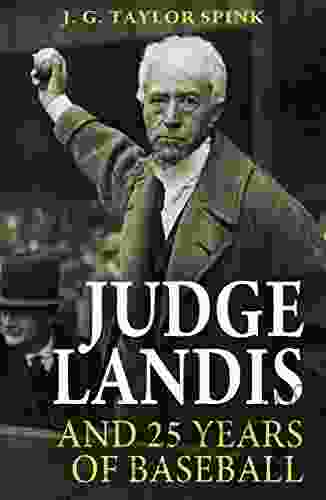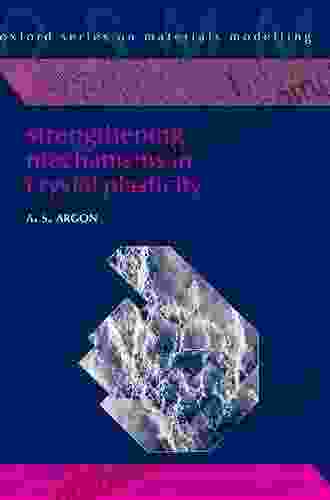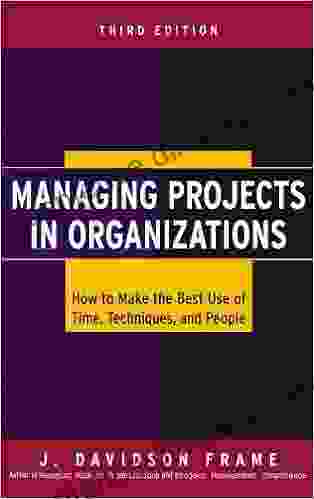Strengthening Mechanisms In Crystal Plasticity

An Oxford On Materials Modelling Publication
The development of high-performance materials requires a fundamental understanding of the mechanisms that contribute to their strength and ductility. Crystals, the building blocks of most engineering materials, exhibit a wide range of strengthening mechanisms that can be tailored to achieve specific material properties.
5 out of 5
| Language | : | English |
| File size | : | 7397 KB |
| Print length | : | 404 pages |
| Lending | : | Enabled |
| Screen Reader | : | Supported |
This book provides a comprehensive overview of strengthening mechanisms in crystal plasticity, covering both theoretical and experimental aspects. It is an essential resource for researchers and engineers working in the field of materials science and engineering.
Dislocation-Based Strengthening
Dislocations are line defects in crystals that play a major role in their mechanical properties. Dislocations can be introduced into crystals by various means, such as plastic deformation, thermal shock, and irradiation.
The presence of dislocations increases the strength of crystals by hindering the motion of other dislocations. This is because dislocations can interact with each other to form junctions and pile-ups, which can block the movement of dislocations and lead to plastic deformation.
Grain Boundary Strengthening
Grain boundaries are the boundaries between adjacent grains in a polycrystalline material. Grain boundaries can act as barriers to dislocation motion, which can lead to strengthening.
The strength of grain boundaries depends on their orientation and character. Low-angle grain boundaries are typically weaker than high-angle grain boundaries. Grain boundaries with a high density of dislocations are also weaker than grain boundaries with a low density of dislocations.
Solid Solution Strengthening
Solid solution strengthening is a strengthening mechanism that occurs when a solute atom is added to a crystal. Solute atoms can interact with dislocations to form Cottrell atmospheres, which can hinder the motion of dislocations.
The strength of solid solution strengthening depends on the size, shape, and concentration of the solute atoms. Solute atoms that are larger than the host atoms are more effective at strengthening than solute atoms that are smaller than the host atoms.
Dispersion Strengthening
Dispersion strengthening is a strengthening mechanism that occurs when a second phase is dispersed in a matrix phase. The second phase particles can act as barriers to dislocation motion, which can lead to strengthening.
The strength of dispersion strengthening depends on the size, shape, volume fraction, and distribution of the second phase particles. Second phase particles that are small, spherical, and evenly distributed are more effective at strengthening than second phase particles that are large, irregularly shaped, and non-uniformly distributed.
Precipitation Strengthening
Precipitation strengthening is a strengthening mechanism that occurs when a second phase precipitates from a supersaturated solid solution. The precipitate particles can act as barriers to dislocation motion, which can lead to strengthening.
The strength of precipitation strengthening depends on the size, shape, volume fraction, and distribution of the precipitate particles. Precipitate particles that are small, spherical, and evenly distributed are more effective at strengthening than precipitate particles that are large, irregularly shaped, and non-uniformly distributed.
Twinning
Twinning is a crystallographic shear transformation that can occur in certain materials. Twinning can lead to strengthening by creating new dislocations and by hindering the motion of existing dislocations.
The strength of twinning depends on the type of twin, the orientation of the twin, and the amount of twinning. Tensile twins are typically stronger than compression twins. Twins that are oriented at an angle to the loading direction are more effective at strengthening than twins that are oriented parallel to the loading direction.
Martensitic Transformation
Martensitic transformation is a solid-state phase transformation that can occur in certain materials. Martensite is a product phase that is typically harder and stronger than the parent phase.
Martensitic transformation can lead to strengthening by creating new dislocations and by hindering the motion of existing dislocations. The strength of martensitic transformation depends on the type of martensite, the orientation of the martensite, and the amount of martensite.
Strengthening mechanisms are essential for the development of high-performance materials. By understanding the various strengthening mechanisms that are available, materials scientists and engineers can design materials that meet the specific requirements of their applications.
Further Reading
- Strengthening mechanisms in crystal plasticity, Acta Materialia, Volume 87, 2015, Pages 1-45
- Strengthening Mechanisms in Materials, Springer, 2016
- Strengthening Mechanisms in Metallic Alloys, Taylor & Francis, 2018
5 out of 5
| Language | : | English |
| File size | : | 7397 KB |
| Print length | : | 404 pages |
| Lending | : | Enabled |
| Screen Reader | : | Supported |
Do you want to contribute by writing guest posts on this blog?
Please contact us and send us a resume of previous articles that you have written.
 Book
Book Novel
Novel Page
Page Chapter
Chapter Text
Text Story
Story Genre
Genre Reader
Reader Library
Library Paperback
Paperback E-book
E-book Magazine
Magazine Newspaper
Newspaper Paragraph
Paragraph Sentence
Sentence Bookmark
Bookmark Shelf
Shelf Glossary
Glossary Bibliography
Bibliography Foreword
Foreword Preface
Preface Synopsis
Synopsis Annotation
Annotation Footnote
Footnote Manuscript
Manuscript Scroll
Scroll Codex
Codex Tome
Tome Bestseller
Bestseller Classics
Classics Library card
Library card Narrative
Narrative Biography
Biography Autobiography
Autobiography Memoir
Memoir Reference
Reference Encyclopedia
Encyclopedia M G Harris
M G Harris Jesse Wiley
Jesse Wiley Sebastian Harth
Sebastian Harth Hubert Haensel
Hubert Haensel Isabel H Stepanian
Isabel H Stepanian Imee Cuison
Imee Cuison Li Young Lee
Li Young Lee Roy N Francis
Roy N Francis Janet Morgan Stoeke
Janet Morgan Stoeke Jean P
Jean P Neil Manthorp
Neil Manthorp Jaret C Daniels
Jaret C Daniels Leslie Harrington
Leslie Harrington Michael S Zambruski
Michael S Zambruski J A Culican
J A Culican Richard Georgiou
Richard Georgiou Humphrey Quinn
Humphrey Quinn Holger Ingmar Meinhardt
Holger Ingmar Meinhardt Stephan L Hatch
Stephan L Hatch Howard Dunkley
Howard Dunkley
Light bulbAdvertise smarter! Our strategic ad space ensures maximum exposure. Reserve your spot today!

 Jaden CoxMacbeth Bloom's Modern Critical Interpretations: A Journey into Shakespeare's...
Jaden CoxMacbeth Bloom's Modern Critical Interpretations: A Journey into Shakespeare's... Dashawn HayesFollow ·7.5k
Dashawn HayesFollow ·7.5k Eli BrooksFollow ·9.3k
Eli BrooksFollow ·9.3k David MitchellFollow ·14.4k
David MitchellFollow ·14.4k Clinton ReedFollow ·16.8k
Clinton ReedFollow ·16.8k Dawson ReedFollow ·6.4k
Dawson ReedFollow ·6.4k Mario BenedettiFollow ·11.4k
Mario BenedettiFollow ·11.4k John UpdikeFollow ·10.6k
John UpdikeFollow ·10.6k Henry Wadsworth LongfellowFollow ·4.4k
Henry Wadsworth LongfellowFollow ·4.4k

 Ike Bell
Ike BellShakespeare and the Imprints of Performance: A Journey...
Unveiling the Dynamic Legacy of...

 Wade Cox
Wade CoxEducational Entrepreneurship Today: The Key to...
What is Educational Entrepreneurship? ...

 Jason Reed
Jason ReedLearn the Parts of the Violin: A Comprehensive Guide for...
The violin is a beautiful and...

 Will Ward
Will WardJudge Landis and 25 Years of Baseball: An Unparalleled...
Buckle up for an extraordinary journey through...
5 out of 5
| Language | : | English |
| File size | : | 7397 KB |
| Print length | : | 404 pages |
| Lending | : | Enabled |
| Screen Reader | : | Supported |














